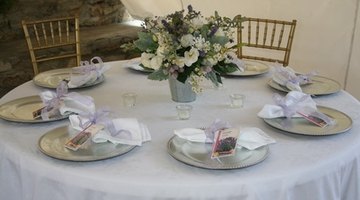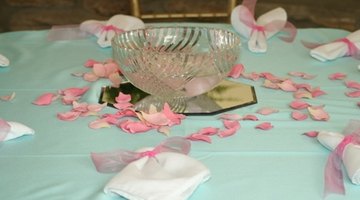The History of Centerpieces
At gatherings and formal events, no table is complete without a centerpiece. Centerpieces can include food, flowers, candles and other decorations. But, table centerpieces are subject to the same vagaries of taste as clothing and accessories. If you're strapped for ideas for an upcoming event, consider some popular centerpiece styles from the past.
Roman Times


The Romans often added decorative foliage to their tables. Other popular centerpieces included vases, other ceramics and dishes of rock crystal.
Middle Ages

Aristocratic tables were often too crowded with food in the Middle Ages to leave much room for centerpieces. However, Christmas centerpieces often included pastry and marzipan shaped to look like people, animals and other decorative objects or scenes.
18th Century

In the 18th century, service à la russe (with servants handing food dishes to the hostess one by one) cleared more room on the table for decorations. Mirrors set up to reflect porcelain figures were a popular choice for aristocrats. Throughout the 18th and 19th centuries, centerpieces were often vertical in shape. These were often constructed using pyramids of food, food arranged on tiered dishes known as epergnes, or using molded puddings and jellies.
19th Century

The custom of adding flowers to the table was revived during the early 19th century. By the late 19th century, flowers and foliage on the table often reflected the season or theme of the event, such as white flowers for a snow-themed event. Candelabras were another popular addition.
20th Century

By WWI, decorative objects began to replace flowers and foliage on the table. These objects were often tied to the theme of the event -- for example, a hostess might add a harp on a green cloth to her St. Patrick's Day table or a miniature windmill for a Dutch-themed event. Later in the century, food came back into style for table centerpieces. During the nature-loving 1960s and 1970s, flowers and grasses returned to the table and never really left.
References
- Roman Life in Pliny's Time; Maurice Pellisson; 1897
- "Albany Times Union"; Table Decor Gets Festive With History; Irene Gardner Keeney; Nov, 1987
- The Saturated World: Aesthetic Meaning, Intimate Objects, Women's Lives, 1890-1940; Beverly Gordon; 2006
- "Edwardian Promenade": Setting the Table
Writer Bio
Bess Lovejoy is a writer and researcher in Seattle, Washington. She was an editor on the Schott's Almanac series of reference books from 2005 until 2010. She has also written journalism for the "Stranger," "Arcade," the "Tyee," "KGBBarLit" and other publications. She graduated from Simon Fraser University in Vancouver, British Columbia, in 2003, and has been writing ever since.
Photo Credits
- table setting image by cherie from Fotolia.com
- foliage image by Ruta Saulyte from Fotolia.com
- marchpanes image by Lani from Fotolia.com
- table setting image by cherie from Fotolia.com
- candelabro_3 image by drakis from Fotolia.com
- plant on table image by araraadt from Fotolia.com
More Articles



